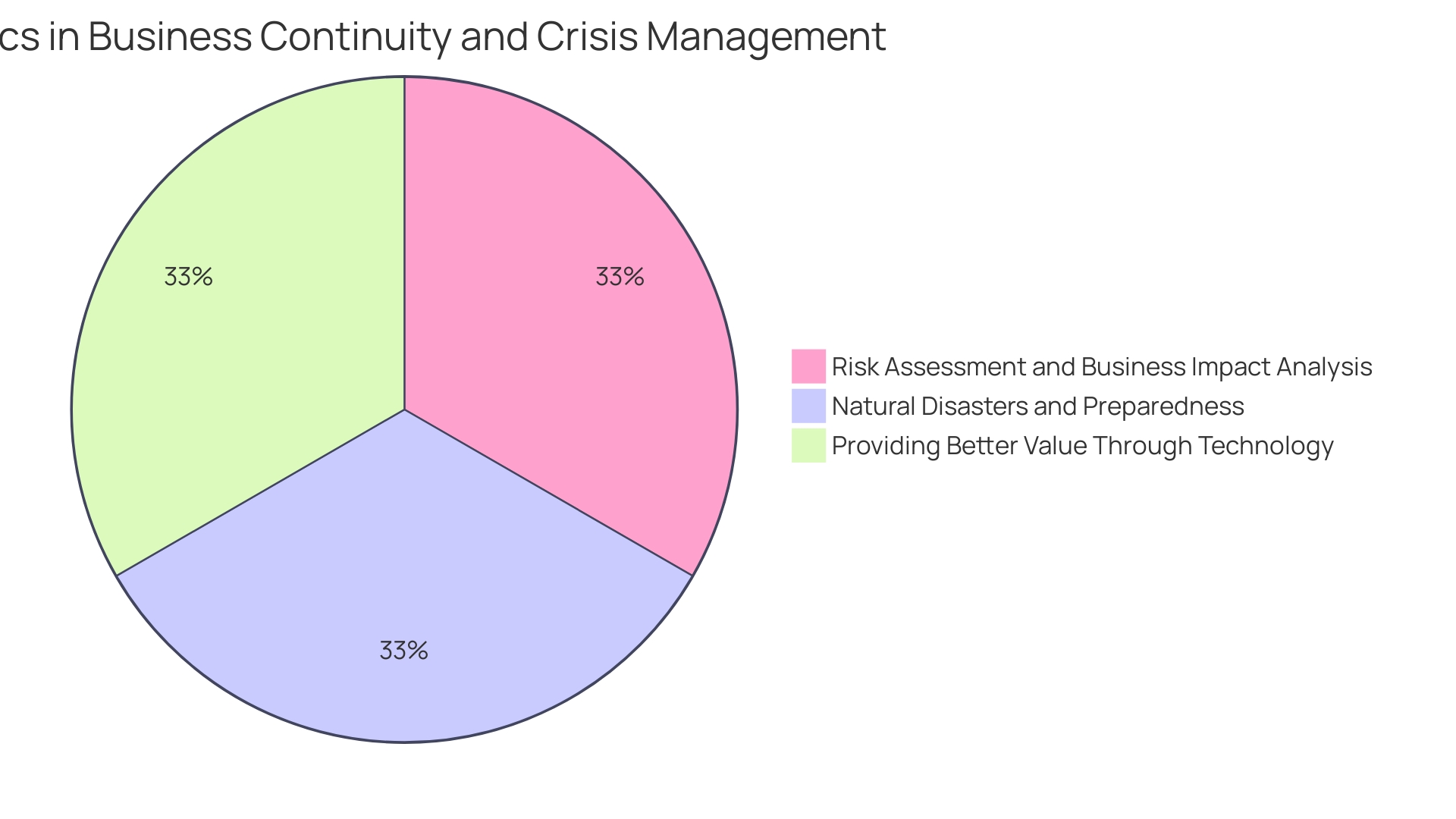Introduction
Turnaround management is a critical intervention for businesses facing operational or financial difficulties, led by professionals who possess a unique set of skills aimed at revitalizing companies. These specialists craft and execute strategies that not only stabilize a struggling business but also steer it towards a trajectory of growth and success. In this article, we will explore the key characteristics of a turnaround manager and the essential role they play in fostering business recovery.
We will also delve into the process of evaluating the business's current reality, setting outcome and goals, developing a turnaround strategy, implementing the plan, monitoring and evaluating results, refining the strategy, ensuring stakeholder engagement, and sustaining the turnaround. Join us as we uncover the practical advice and solutions that can help businesses navigate through challenging times and emerge stronger than ever.
What is a Turnaround Manager?
Turnaround management is a critical intervention for businesses facing operational or financial difficulties, led by professionals who possess a unique set of skills aimed at revitalizing companies. These specialists craft and execute strategies that not only stabilize a struggling business but also steer it towards a trajectory of growth and success. A case in point is the transformation of a centrally located branded hotel's restaurant which, despite its prime location, was underperforming in food and beverage sales. Through a strategic overhaul that capitalized on the restaurant's location, the turnaround resulted in exceptional reviews and a significant surge in sales within the first week. This turnaround was achieved by understanding the market dynamics and identifying areas where immediate impact could be made, reflecting the multifaceted approach required for business recovery.
In the broader context of business management, project managers share a kindred spirit with turnaround managers as they bring visions to fruition and ensure that project outcomes are in harmony with the company's strategic objectives. They are instrumental in delineating project scope, crafting detailed plans, and meticulously tracking progress to manage resources effectively, particularly in small businesses where efficient resource allocation is paramount.
The role of a business development manager intersects with that of a turnaround manager in the sense that both focus on fostering growth and increasing profitability. Business development involves a diverse spectrum of activities including market research and strategic planning, which are vital in identifying new opportunities and cultivating customer relationships.
A strategic approach to expenditure is indispensable in any business turnaround effort. It necessitates a judicious review of all spending, prioritizing investments that align with both immediate needs and long-term business goals. Decisions must be weighed against their potential to benefit the team or clients and to advance the company's marketing and sales objectives.
Statistics highlight the precarious nature of startups, with only about half surviving beyond five years. Yet, the rewards can be substantial, offering founders the autonomy to innovate and potentially reap considerable financial benefits. Nonetheless, the high incidence of company insolvencies, with over 25,000 cases recorded in a single year, underscores the importance of sound financial management and the indispensable role of turnaround managers in navigating the complexities of business recovery.
Key Characteristics of a Turnaround Manager
The role of a turnaround manager is pivotal in revitalizing a struggling business. To navigate through this challenging process successfully, certain attributes are indispensable. A turnaround manager must exhibit robust leadership, not only to steer the organization but also to galvanize the team towards a shared vision. The ability to face and make difficult decisions is crucial, as these choices often impact the company's trajectory towards recovery.
Problem-solving prowess is another vital trait, allowing for creative and effective solutions to the myriad of issues that may arise. Financial acuity is a fundamental skill set, as understanding the intricacies of financial management is necessary to identify areas of improvement and implement cost-saving measures. This knowledge is also essential in detecting early signs of change, such as anomalies in financial performance that may indicate the need for strategic adjustment.
Moreover, the turnaround manager must be a source of continuous inspiration and motivation for their team. During periods of uncertainty, such as the threat of layoffs, maintaining morale and showing appreciation for team members is paramount. A caring approach to team management can significantly impact employee retention and overall company health during challenging times.
A business manager's role is to act as the glue that holds different facets of a company together. This involves coordinating operations, onboarding new employees, and aligning business strategies with the company's goals. Innovations in hiring, such as crafting engaging job descriptions, play a part in attracting the right talent, which is essential for a company undergoing a turnaround.
The value of effective project management can't be understated in this context. A project manager's responsibilities extend to resource allocation, task orchestration, and challenge navigation, which are vital in executing a successful turnaround strategy.
Embracing the principle of being 'Ruthlessly Constructive' is beneficial for a turnaround manager. This approach encourages open, forward-looking criticism that focuses on finding solutions beneficial to the organization. Learning from feedback and adapting strategies accordingly is a trait shared by effective leaders, as it fosters continuous evolution and improvement.
In essence, the successful turnaround manager combines a strategic mindset with a human touch, ensuring that while the company's financial and operational needs are met, the workforce remains engaged and committed to the company's revival.
The Essential Role of a Turnaround Manager
When a business is in distress, the introduction of a turnaround manager often marks the beginning of a critical recovery phase. This specialized role involves a multi-disciplinary approach to addressing the challenges at hand. A recent success story from the hospitality sector illustrates this: a major hotel, despite its prime city center location, struggled to boost its food and beverage sales. An innovative strategy to leverage its location resulted in a surge of positive reviews and a significant uplift in sales within the first week.
Turnaround managers excel in conducting market research, identifying the blind spots within a company's strategy, and pinpointing untapped opportunities for growth. They are adept at crafting actionable plans that align with long-term business objectives. Their comprehensive solutions take into account the diverse aspects of a business, from sales and marketing to project management, ensuring that each department contributes to the overarching goal of profitability and sustainability.
The contemporary business landscape, as highlighted by recent economic disruptions, underscores the necessity for agility and strategic foresight. Companies that emerge stronger from economic downturns are often those that have made calculated investments, divested non-core assets to streamline operations, and embraced technological advancements to enhance efficiency.
In times of crisis, the ability to make prompt and informed decisions is paramount, as historical figures like John D. Rockefeller have noted. A turnaround manager's decisive actions are informed by the understanding that the initial response to a crisis can set the tone for either a swift recovery or an extended period of hardship. Their ability to pivot, adapt to changing market needs, and innovate is not just a reactionary measure to crisis but a proactive stance for continual evolution.
Statistics reveal the stark reality of business difficulties, with a notable increase in company insolvencies. In 2023, the number of company insolvencies reached 25,158, the highest since 1993, indicating the heightened importance of effective turnaround management. Businesses that focus on developing a robust, adaptable strategy, backed by solid market research and a clear understanding of customer needs, are better positioned to navigate the complexities of the modern economy and achieve long-lasting success.
Evaluating the Business's Current Reality
To successfully navigate through a business crisis and initiate a turnaround, a comprehensive assessment of the company's current state is imperative. This crucial first step involves an in-depth analysis of financial statements and operational data, pinpointing weaknesses, and identifying the core issues that led to the predicament. For example, when Nets, a digital payment solutions provider, faced the challenge of presenting technical data, they reimagined their approach to convey information in a more engaging and accessible manner. Similarly, understanding the intricacies of your company's situation is essential for developing effective strategies to address the crisis.
The evaluation should not only cover financial performance but also operational efficiency and market position. Financial analysis should review key metrics such as revenue growth, profit margins, and cash flow, while also considering how well the company has managed investments and costs. Additionally, analyzing how the company has adapted to market shifts, customer preferences, and technological advancements can shed light on its agility and capacity for innovation.
For instance, Northvolt, amidst its strategic review, took decisive actions to reinforce its financial stability and operational performance, highlighting the importance of strategic planning and the willingness to adapt to maintain competitiveness. This approach is reinforced by the fact that only 25% of small businesses survive beyond 15 years, underscoring the need for continual assessment and adjustment.
Moreover, companies within regulated sectors, such as finance, must remain vigilant about compliance with international regulations, including fraud protection and anti-money laundering laws. This vigilance is a part of the comprehensive review process, ensuring that all aspects of the business align with current standards and practices.
Incorporating these multifaceted evaluations into the annual business review process can significantly contribute to a company's ability to realign with its long-term objectives and regain a stable footing in the market.

Setting Outcome and Goals
To facilitate a successful business turnaround, it's imperative to begin with a comprehensive evaluation of the company's present condition. This assessment should reflect on the previous year's objectives and what was learned from them. A detailed SWOT analysis is instrumental in identifying the strengths, weaknesses, opportunities, and threats facing the business, which provides a solid foundation for setting new, realistic goals.
The objectives formulated should not only be ambitious but also attainable, taking into account the company's existing capabilities and market position. For instance, aiming to boost business revenue by 20% within a year could be a realistic goal if supported by a well-devised strategy and available resources. It's crucial to avoid setting vague targets, such as "create more widgets than last year," which can lead to confusion and hinder progress.
Goals should be crafted to be Specific, Measurable, Achievable, Relevant, and Time-bound (SMART). This approach ensures that each goal is clear and trackable, facilitating accountability and allowing for adjustments as needed.
Take inspiration from successful case studies, such as the Guthrie Clinic's holistic healthcare strategy or the targeted marketing efforts of a city center hotel that leveraged its location to attract more diners, resulting in increased sales and excellent reviews. These examples demonstrate the power of a well-structured, solution-driven process in achieving significant outcomes.
Remember, the essence of setting practical and challenging goals lies in the balance between aspiration and feasibility, ensuring that each step taken is a stride towards the ultimate vision of business revival and growth.

Developing a Turnaround Strategy
Crafting a comprehensive turnaround strategy is a pivotal step that involves detailed planning and execution to steer an organization back to success. It's not merely a set of actions but a transformation journey that demands continuous evaluation and adaptation. Drawing from Strategic Solution Partners' approach, it's clear that addressing unique client needs with tailor-made solutions can significantly enhance revenue and operational efficiency. Similarly, the City of Thunder Bay's asset management planning showcases the importance of cross-departmental strategic priorities and proactive decision-making to minimize future risks and preserve organizational knowledge.
Moreover, as industry sectors like food and beverage, and healthcare services demonstrate resilience during economic downturns, it's evident that certain strategies can thrive in adverse conditions. This resilience is a testament to the robust nature of well-conceived turnaround strategies, underscored by the words of James Mohs, who emphasizes the criticality of exhausting all options before considering bankruptcy.
The process of transformation must be continuous, as indicated by research that suggests a significant portion of businesses need to adapt every few years to remain competitive. This is particularly relevant in light of digital transformation projections, where effective change management is crucial in supporting employees and ensuring the intended outcomes of new technologies and processes are met. However, with approximately 66% of change initiatives failing, a structured and dynamic approach to strategy development and execution becomes even more crucial. By learning from past experiences and building for the future, businesses can navigate through transformation more successfully, staying different and valuable in a competitive market.

Implementing the Turnaround Plan
The role of a turnaround manager is pivotal in bridging the gap between a faltering business and a flourishing enterprise. They are tasked with executing the turnaround plan, which requires a decisive and informed approach to restructure the company's operations. In one transformative case, a major hotel located in a prime urban setting successfully reinvigorated its food and beverage sales by adopting strategic measures that capitalized on its central location. This change was guided by a clear understanding of the market and a multi-disciplinary strategy, which led to a significant surge in sales and positive customer feedback within the first week of implementation.
In another instance, the Guthrie Clinic's commitment to community health saw them take a holistic approach to patient care, integrating physical, emotional, and social aspects into their healthcare services. This comprehensive strategy extended beyond the clinic's walls, actively engaging in community outreach and partnerships, thereby enhancing overall community well-being.
Moreover, the importance of a well-thought-out action plan cannot be overstated. It serves as a roadmap, directing businesses like these from their current state to their desired goals. Such plans are not just theoretical constructs; they are practical tools that encompass various aspects of a business, from financials to human resources.
In times of economic uncertainty, it’s crucial for businesses to make informed decisions rather than reactionary ones based on fear. As one expert on small businesses wisely suggests, bold and strategic actions, as opposed to retrenchment, can pave the way for success in challenging times. This is echoed by the benefits of consulting, where expertise from specialists can provide a breadth of knowledge to navigate through industry challenges and optimize business operations.
The beauty industry provides a further example of strategic growth through the utilization of grants. With up to $100,000 available, savvy business owners can finance expansion, innovate products and services, and enhance employee skills. Grants like these represent valuable opportunities for businesses to launch or expand without bearing the full financial burden themselves.
Finally, technology projects are a testament to the necessity of a solid change management plan. Statistics reveal a disheartening success rate of 16% to 30% for technology projects, often due to the absence of robust executive sponsorship and change management. This underlines the significance of strategic planning and execution in turning around business fortunes and highlights the role of a turnaround manager in steering the ship to calmer, more profitable waters.
Monitoring and Evaluating Results
The role of a turnaround manager is akin to a captain navigating through a storm, constantly adjusting the sails and course to reach the destination safely. With their hands firmly on the helm, they meticulously track key performance indicators (KPIs), recognizing that, as management guru Peter Drucker famously said, "What gets measured gets managed." These KPIs act as a lighthouse, providing crucial insights into the organization's financial health, operational efficiency, and customer satisfaction.
In the same vein, the success of digital health platforms like Rwanda's integrated electronic medical record system demonstrates the power of effective monitoring and adjustments. This system, bolstered by essential infrastructure, is a beacon of progress in a nationwide digitization strategy, underlining the importance of adapting and refining processes to achieve desired outcomes.
For products that aren't cloud-based, such as on-premise solutions critical to infrastructure, the approach differs. Here, the use of Monte Carlo Simulations has proven instrumental in planning and managing release schedules. This strategic tool allows for better prediction of when features will be completed, ensuring that updates are timely and in sync with customer expectations, as evidenced by the experiences shared by organizations with a history of adapting to technical debt.
Quantifying impact and success requires a comprehensive view—inputs, outputs, and outcomes must all be considered. This holistic approach is reflected in the balanced scorecard method, which examines an organization from financial, internal business, innovation, learning, and customer perspectives. Each angle is critical to creating a nuanced understanding of progress toward strategic goals.
Ultimately, listening to signals from both the team and customers is vital to gauge the right moment for change. An organized process for assessing, planning, and implementing changes ensures that the business can navigate through challenges, much like the careful execution required in mergers, acquisitions, or sales. It's the synergy of these multifaceted strategies that supports a resilient turnaround, steering the organization toward sustainable success.
Refining the Strategy
In the dynamic landscape of business turnaround, a manager's ability to adapt and refine the strategy in response to market feedback is crucial. Recognizing the importance of agility, they stay vigilant to the shifting tides within the industry, pivoting away from underperforming strategies with the acumen of an experienced navigator. The key lies in identifying unique value propositions, carving out a niche that differentiates the brand from its competitors.
A compelling example of strategic agility can be found in the hospitality industry, where a major hotel leveraged its prime location to significantly boost Food & Beverage sales, despite previous stagnation. This underscores the value of understanding one's market and the power of location-based strategy in driving business growth.
Drawing from broader market observations, it's clear that being better isn't always the answer—sometimes, being different is. This is echoed by the voices of thought leaders who caution against the pitfalls of doubling down on failing strategies, which can spell disaster for even the most established brands.
In today's fast-paced environment, the efficacy of a business strategy is reflected in its operational results. Sales statistics and market trends provide an unvarnished glimpse into the successes and failures of strategies across industries, revealing that a strategic plan is not just a document but a living process that requires constant evaluation and adjustment.
These insights are further reinforced by the startup ecosystem, where the freedom to innovate is often counterbalanced by the stark reality of high failure rates. Startup statistics illuminate the volatile nature of entrepreneurship, emphasizing the importance of resilience and the willingness to pivot as key factors in long-term survival and prosperity.

Ensuring Stakeholder Engagement
Effective stakeholder communication is a linchpin of successful business turnaround strategies. It is essential to keep all parties from shareholders to customers adequately informed, thereby fostering confidence and mitigating concerns. For instance, when the Ford Foundation recognized the need to better serve its audience's evolving needs through its digital platforms, they revolutionized their content management system. This strategic move, as described by Bedirhan Cinar, Head of Product and Digital Engagement, led to a significant increase in content publication without compromising workflow efficiency.
A similar approach was employed by a city-center hotel, which initially struggled to boost its food and beverage sales. By adopting a strategic plan that leveraged its prime location and understood market needs, the hotel witnessed a notable surge in revenue, as emphasized by industry expert John Young. This underscores the importance of stakeholder analysis to identify, learn about, and prioritize stakeholders, thereby minimizing hurdles for a successful outcome.
The need for transparent stakeholder communication is further highlighted by the current emphasis on ESG reporting. As noted by Bob Moritz, Global Chairman of PwC, and Lawrence Di Rita of Bank of America, ESG reporting is no longer optional but a critical element of corporate responsibility that requires a harmonized approach to meet stakeholder expectations.
Additionally, the overarching goal of any business should be value maximization, which is intricately linked to effective stakeholder engagement. Companies must develop organized processes to listen, understand, and analyze change opportunities, ensuring that any business pivot is supported by thorough execution and clear communication with all stakeholders involved. Failure to do so could result in missed opportunities for growth and profitability, as evidenced by the challenges faced by many emerging companies in sectors such as social media, tech, and green energy.
Sustaining the Turnaround
After stabilizing the company's finances and navigating through the crisis phase, the focus of a turnaround manager shifts towards reinforcing the recovery. This involves strategizing to keep the business on an upward trajectory, constantly seeking betterment, and embedding a culture that prizes ongoing progress and prosperity.
Stora Enso's transformation from a traditional paper manufacturer into a renewable materials leader exemplifies such a strategy in action. Observing the decline in global paper demand, Stora Enso reinvented itself to stay relevant and profitable. This pivot was propelled by a strategic decision to leverage the cash flow from their paper business to invest in burgeoning opportunities within the renewable materials sector.
A similar mindset can be seen in Levi Strauss's approach to water conservation. By setting ambitious water use targets for 2025, the company not only addresses environmental concerns but also mitigates risks within its supply chain, demonstrating proactive and strategic management.
KPIs are the compass that guides sustained improvement. By tracking the right metrics, businesses gain insights into financial health, operational efficiency, and customer satisfaction, enabling them to manage and improve continuously.
Moreover, diversifying revenue streams, akin to a 'Diversified Revenue Portfolio' from the finance world, can provide stability and resilience. This strategy ensures that if one area underperforms, the others can sustain the business, a practice that can be vital in times of uncertainty.
In essence, the path to long-term success is paved with strategic planning, continuous improvement, and the agility to adapt to emerging market trends. As businesses implement these strategies, they not only survive but also set themselves up for a future of growth and innovation.

Conclusion
In conclusion, turnaround managers play a crucial role in revitalizing struggling businesses. With robust leadership, problem-solving skills, and financial acuity, they navigate through challenges and inspire their teams. Evaluating the current reality and setting achievable goals are vital for driving business revival.
Crafting a comprehensive turnaround strategy involves adapting and refining based on market feedback. Implementing the plan requires decisive action guided by well-thought-out action plans. Monitoring key performance indicators allows for adjustments and refinements.
Effective stakeholder engagement builds trust and maximizes value. Sustaining the turnaround involves continuous improvement, diversifying revenue streams, and strategic planning. Turnaround managers provide practical advice to help businesses navigate through challenges and achieve growth and success.




